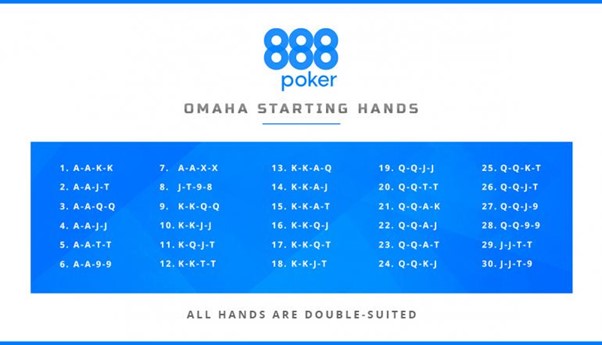Pot Limit Omaha is referred to lovingly as the ‘Ferrari’ of poker. It’s fast, exciting and full of action.
In this article we’ll cover all you need to know on how to play PLO poker to get started at the 888poker PLO tables.
|
PLO Meaning by Poker Definition |
PLO Poker Rules
Check out this comprehensive YouTube video series by 888poker ambassador and PLO Queen Vivian Saliba on all things Pot Limit Omaha.
PLO shares a number of similarities with Hold’em.
Similarities
- Action is split across four betting rounds referred to as preflop, the flop, the turn and the river.
- The action begins with mandatory wagers referred to as the small blind and the big blind.
- Action precedes in a clockwise direction around the table and is determined by a “button”.
- Players use a combination poker of hole cards and community cards in order to make the best five card hand.
- Players win a hand of poker either by having the best hand at showdown or by being the last player remaining in the hand after all other players fold (give up).
- Players may bet, call, fold, or raise on each betting round. The betting round concludes when all players agree on a wager amount or only a single player is left in the pot.
There are also some key differences in PLO poker meaning and the way that PLO is played.
Differences
- Players are dealt four hole cards instead of two.
- Players must use exactly two of their hole cards when making a hand.
- The maximum allowed bet at any given point is the size of the current pot.
PLO Poker Starting Hands

The best starting hands in PLO are the ones where all four cards work well together, which begs the question "What is PLO in poker?"
Players from a Hold’em background often overvalue hands like AKxx and AAxx simply because these hands are strong in Hold’em. They are confused on how to play PLO poker.
In PLO, the strength of these hands is determined by how well the other two cards co-ordinate. For example, AAKK and AAJT are very strong because all of the cards work together.
We should also pay attention to the suitedness of our starting hand.
Double Suited – We have two sets of cards that share the same suit. Example AdJdTh9h
Single Suited – We have 2 (or more) cards of the same suit. Example AdJdTh9c or AdJdTd9c
Rainbow – There are exactly four suits in our starting hand (no two cards share the same suit). Example AdJsTh9c
Double Suited hands are the best, followed by single suited, followed by rainbow. When holding a single suited hand, it is better to have exactly two suited cards rather than three or four.
Hands such as AdJdTd9d are problematic because there are now less community cards available in the deck that can be used to make a flush.
Since there are 270,725 possible starting hands in PLO, preflop poker hand rankings selection can seem overwhelming to a new player.
The following is a good general rule of thumb of absolute beginners.
The more high-cards in our starting hand the better.
For example, a holding like AKQT is nearly always playable, even if it is rainbow.
We also like hands with big pairs (e.g. AKKT) and hands with lots of connectivity (e.g. JT98).
Hands with four cards in a row are referred to as rundowns in PLO.
Rundowns are at their strongest when there is no gap in the structure. I.e. JT98 is stronger than JT87 although both can be described as rundowns.
PLO Poker Strategy

PLO is often described as “a game of the nuts”. PLO poker rules and PLO poker strategy can be tricky. There is no room for Texas Hold’em cheat sheets because it is much easier to make big hands in PLO compared to Hold’em.
Our general objective should be to try and make the nuts (or close to it) before investing a big percentage of our stack. Of course, it’s not quite that simple in reality. But it’s a great starting point which helps us to avoid common beginner mistakes.
By far the most common mistake that new PLO players make is overvaluing hands that are strong in Hold’em. Hands like overpairs and dominated flushes/straights are typically very strong in Hold’em but are big danger hands in PLO.
Similarities with Hold’em
Here are some aspects of PLO Poker strategy that match up with Hold’em -
Position –
Acting last on each betting round gives us a big advantage and allows us to continue with a wider range of hands profitably.
Odds and Outs –
Pot odds and implied odds work in the same way as they do in Hold’em. (We’ll often have a lot more outs in PLO compared to Hold’em though!)
Board Texture –
The board texture has a big impact on how aggressively we should be playing, and which hands are likely to be best.
General Preflop Approach –
While preflop play is clearly different in PLO, some things never change. For example -
- We should usually either be raising first in or folding (never limping) if the action is folded around to us preflop.
- We should defend a wide range of hands out of the big blind when facing an open.
- We should play more hands in late position compared to early position.
Advanced PLO Poker Strategy
The world of PLO poker strategy is rich and nuanced and like Hold’em, can take a lifetime to master.
Let’s consider two important aspect of PLO poker strategy that advanced players make use of on a regular basis.
The Freeroll Concept
The nuts is not always the nuts in PLO.
Imagine two players make the nut straight.
Take a look at the following example, ignoring any suits:
Board: T76
Player 1: 8923
Player 2: 89TJ
Both players have the nut straight, but any 8 or 9 will give player 2 a higher straight. Player 2’s ‘nuts’ is quite a bit stronger than player 1’s ‘nuts’.
Although player 1 has the ‘nuts’ his hand is only worth about 40% of the total pot. In this example we can say that player 2 is ‘freerolling’ - in poker lingo - his opponent. They’ll either chop or win the entire pot outright.
It's always essential to pay attention to redraws in PLO. If we have the ‘bare’ nuts without redraws (like Player 1), it often makes sense to play the hand more cautiously.
On the other hand, if we suspect there is a chance that we are freerolling our opponent, we should often look to get the chips in as fast as possible.
Mastering Wraps
Straight draws in Hold’em are straightforward: They always have either 4 or 8 outs.
In PLO, our straight draws can have 4 outs, 8 outs, 9 outs, 13 outs, 17 outs or 20 outs - and that’s not even the full list!
A straight draw with 9 or more outs is referred to as a ‘wrap’ in Omaha.
Mastering wraps takes practice. Advanced players should look at their and hand and quickly figure out the following -
- The exact number of outs a hand has to complete its straight.
- The number of those straight outs that make the nut straight.
Here is quick example of a PLO wrap -
Board: 892
Hand: QTJ3
This particular wrap is known as the ’13-out nut wrap’.
The outs to make a straight are as follows:
|
Turn Card |
# of outs |
|
7 |
4 |
|
T |
3 |
|
J |
3 |
|
Q |
3 |
Total Outs – 13
Number of Nutted Outs - 13
Expert players can spot all of the different types of wrap at a glance. This skill can take quite a while to master since there are quite a number of different types of wrap.
PLO Poker Tips
Here are some top tips for getting started with PLO:
Tip 1 – PLO is about nutted hands.
It's essential not to value postflop hands the same way as we do in Hold’em. A strong hand in Hold’em might be extremely weak in PLO. Be especially careful with AAxx postflop.
This hand is nowhere near as strong as the AA overpair in Hold’em, especially if the side cards are disconnected.
Tip 2 – Look for 4 card co-ordination preflop.
The best hands in PLO have co-ordination across all four cards. The second best hands have strong co-ordination across 3 of the 4 cards.
Hands that have limited co-ordination or only 2-card co-ordination are very weak in PLO and should often be discarded preflop depending on the action.
Tip 3 – Understand the freeroll concept.
Even when we have a made hand, we should pay attention to whether we have any redraws to something even stronger. There is a chance that our opponent has exactly the same hand as us. The quality of redraws will determine which hand is strongest overall.
Tip 4 – Learn the big draws.
In Hold’em, a draw is nearly always weaker than a made hand (at least in terms of pot equity). In PLO, big combo draws can become so powerful that they are a favourite to win the pot - even against strong made hands.
In such situations, we can play our big draws similarly to a strong value hand.
PLO Poker Meaning Summary
With the addition of two extra hole cards, PLO is an extraordinarily complex game to master. That said, it undoubtedly provides an added thrill with more possibilities and better odds at making a strong hand.
This 888poker article is an introduction to getting your feet wet in the game. Further study and reflecting on your gameplay and results can make you an accomplished player.
Lastly, remember that PLO is going to carry with it a much higher degree of variance.
As such, it’s essential to be well bankrolled to accommodate the swings that naturally come along with this great game.


